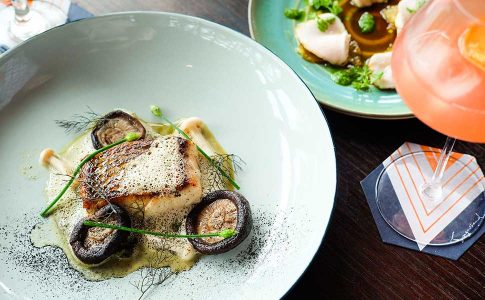Inspired by Indonesia, made in Bali. Photos: Lucky 8.

The Good Food Brotherhood are well established for their hip and healthy cafes, Watercress and Milk&Madu, yet something was missing in their culinary lives. Often on the road, searching for new sites and inspiration, the brothers in business, Jordy and Pablo, found themselves craving Indonesian food. It’s an easy thing to find but the quality can vary enormously.
Named for the stone mortar and pestle that is found in almost every home across the archipelago, Indonesian dishes start with their spice paste and build on flavours from there. Getting that authentic spice profile is absolutely essential to achieving the end result. As with everything they do, these boys have put effort in here and the proof is in the air as you wander in.
“The food we often find ourselves craving is really good local food; nasi campur, sates, nasi goreng and some of the flavourful vegetable dishes and raw salads the Indonesians do so well. A lot of our friends were feeling the same,” explains Pablo, who spent a lot of his childhood in Bali.
So the pair decided to give birth to their own version of a warung; one that tourists wouldn’t be hesitant to try.
“There’s a perception out there that street food can be dodgy, or loaded up with msg, over-fried or created with inferior quality ingredients, and it can be. We just wanted to create a place where we would like to eat ourselves and hopefully other people would too,” explains Jordy.
Ulekan is a stylish, breezy café that is a simple wantilan-style building, styled up with black and white tile floors, a wide bar, swirling overhead fans and chic rattan lights. The location in Berawa right next door to a beautifully appointed Balinese temple adds to the atmosphere. The music is cool, the service is brisk and efficient and the small menu touches on all the favourites.

The dish of choice for most is the nasi campur. A beautifully presented version of the most popular items on the menu built around a central mound of organic red or white rice. Nasi Campur is the way most Indonesians build their daily meals, assorted dishes served with rice. At Ulekan they have made it artful and available with or without meat. Don’t for one moment imagine that this is simply Indonesian food in a nicer location.
Each dish is full of flavour and beautifully prepared. A revelation for many, who, like me, think they don’t like Indonesian food. For those who are converted, Ulekan will come as a very pleasant surprise.
In trendy Berawa blogger-land there are already a host of Instagrammers lining up their shots before tucking in. Thankfully, all I have to do is eat.
A very refreshing pineapple and coconut granita set me up well for this lunch. The menu travels from warung classics like Gado Gado to a menu of selected sates. An Ulekan salad may have made my list if I hadn’t cast my eye elsewhere. The tempting main course-sized salad bowl is piled high with crunchy house salad, coconut and turmeric poached chicken, crispy rice, snake beans, baby eggplant, herbs and a chili and kaffir lime dressing. It looked vibrant and fresh.
Other classics on the menu include mie goreng (friend noodles), sop buntut (oxtail soup), soto ayam Madura style (a popular chicken soup with rice noodles and bean sprouts), and rawon Ulekan, a thicker version of the oxtail soup.
What caught my eye though was the build-your-own rijstaffel menu. Rijstaffel is a style of eating introduced by the Dutch as a way to entertain guests with a range of local dishes. Often whatever the cook could manage. It’s a multi-course meal that is still popular.

At Ulekan they have scaled down popular mains to offer a taste of the menu all in smaller portions. There are 15 dishes to choose from and 4-5 per guest is recommended on the menu. They range from Rp8,000 for daun sinkong, cassava curry, to Rp25,000 for the kare sari laut, a seafood curry. Order as many or as few as you like and a small bowl of rice and your lunch is made to order.
I chose a beef rendang, an absolute classic in flavour and appearance, but this one is made from beef cheek, simmered long and slow. The dish was spot on and the meat was melting, really a beautiful rendition of this dish.
I also ordered cap cay, the much adulterated dish served in warungs everywhere, with over-stewed vegetables floating in a watery broth. This little tiny gem was bursting with freshness, poured into a tiny bowl of beautiful broth. Possibly one of the best I have had.
My favourite of all though was the classic kare ayam, chicken curry. The creamy turmeric-spiked sauce was good enough to eat with a spoon. OK, I did. The chicken was tender, not stringy or chewy, as is often the case.
My red rice (I famously avoid rice) was nutty, topped with fried shallots and mostly found it’s way into the broth from the cap cay.
I simply had to put my dessert pants on and the small but sweet menu promised all the inherent sweetness that the locals love. I opted to try a Balinese Banoffee, with the waiter’s promise that it was the sweetest thing on the menu. Well it didn’t disappoint. Sweet, yet but with an earthy toffee flavour and a crumble crust that gave it great texture. I could only manage a couple of bites but a deft hand in the pastry department created this, in fact I think I preferred it to the original.
Ulekan is a perfect hybrid of the Canggu café meets local warung. There are loads of Instagram opportunities, and the food is fresh, delicious and not too heavy. It’s a great place to pop in and put a few local dishes under your belt. You’ll like it, I did. S.D.

































